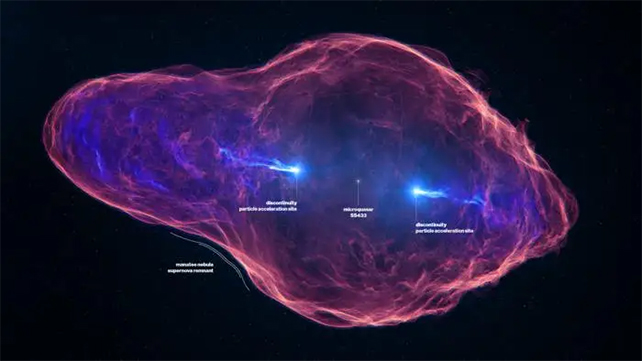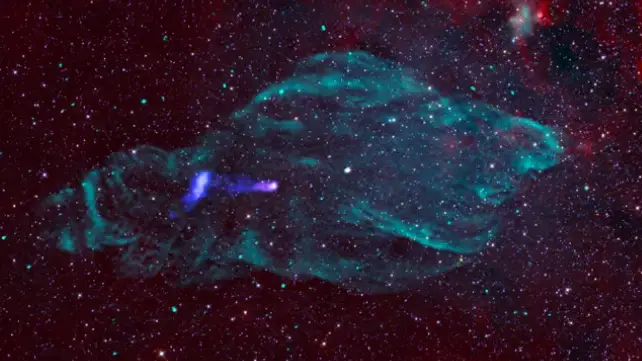Distinctive Trait of a Proximate Black Hole May Hold the Key to Resolving the Enigma of Cosmic Rays
Scientists are gaining a better understanding of the enigmatic cosmic rays that travel through space and reach Earth at incredible speeds, thanks to the discovery of a small black hole. These high-energy cosmic rays have long puzzled researchers, who have been uncertain about how they can reach our planet with such velocity.
In a groundbreaking development, scientists have identified a naturally occurring particle accelerator near the black hole, which is responsible for accelerating the cosmic rays bombarding Earth. This finding marks a significant milestone in our quest to comprehend the origins and mechanisms behind these cosmic phenomena.
Laura Olivera-Nieto, a researcher from the Max-Planck-Institut für Kernphysik in Heidelberg and one of the authors of the study, expressed the significance of this discovery. Previously, scientists could acknowledge the existence of particle acceleration but were unable to determine the specifics. However, with this new breakthrough, we are now entering an era where we can finally provide answers regarding the precise locations and mechanisms involved in this cosmic phenomenon.

Speedy cosmic rays come from black holes and exploding stars
Our world is immersed in an ocean of cosmic rays. These electrically charged particles traverse the vast expanse of the Universe, carrying an immense amount of energy.
If these rays were to directly impact our planet, life as we know it would be impossible. Cosmic rays travel at nearly the speed of light, allowing them to effortlessly pass through our bodies like air. The sheer energy they possess would cause our DNA to be torn apart.
Fortunately, the Earth’s atmosphere acts as a shield, safeguarding us from the most harmful effects of this radiation. Nevertheless, it remains crucial for us to comprehend the origins and behavior of cosmic rays within our Universe. This knowledge becomes even more significant as numerous nations invest in the pursuit of establishing humans as a multi-planetary species in the future.
One aspect that continues to elude our understanding is how these cosmic rays attain such incredible speeds.
Peering at the heart of a jet
Typically, when scientists observe cosmic rays originating from quasars and supernovae, they usually perceive them as a large, indistinct mass. These high-energy cosmic rays emitted by quasars are situated at such vast distances that if they were any closer, they would cause a catastrophic explosion in the Milky Way. Consequently, their detailed examination becomes quite challenging. On the other hand, supernovae, although closer in proximity, emit low-energy rays that appear extremely faint when observed through Earth-based telescopes.
However, a cosmic entity known as SS 433, which is located nearby, presented a unique opportunity to delve into cosmic rays with an unprecedented level of detail.
SS 433 is classified as a microquasar, signifying that it is a small black hole approximately ten times the mass of the Sun. It resides within the Manatee nebula, a gas cloud formed by the remnants of a stellar explosion that occurred around 18,000 light years away.
Olivera-Nieto, a researcher, explained, “It’s referred to as a microquasar because it resembles a miniature version of these celestial objects.”
This implies that SS 433 is weak enough to be situated in close proximity to us, yet possesses enough strength to emit higher energy particles compared to a supernova.
Olivera-Nieto further emphasized the uniqueness of this microquasar, stating, “What makes this microquasar so ‘special’ is the fact that it has been emitting jets for 50 years, which is extraordinary because it is the only known object that has become ‘stuck’ in this state.”
Upon examining SS 433, Olivera-Nieto and her colleagues discovered a significant gap in the emitted jets. They observed small spirals surrounding the black hole, located approximately 0.1 parsecs away, followed by a complete absence of jets. The jets then reappeared approximately 75 light-years further away.
Scientists theorize that this gap is where particles are being accelerated to nearly the speed of light.
The location of the accelerator tells us how it works
Scientists have put forth three theories to elucidate the functioning of this natural particle accelerator.
The first theory suggests that the particles are carried by magnetic field lines surrounding the black hole. These particles experience immense tension, causing them to snap violently and propel into space. However, this theory implies that the accelerator would be in close proximity to the black hole.
The second theory proposes that the black hole generates tunnels that enhance the particles’ speed as they rebound off the tunnel walls. Consequently, the particles would gradually accelerate.

However, recent observations have provided support for a third hypothesis. According to this hypothesis, the particles encounter an imperceptible barrier, known as a discontinuity, which abruptly halts their progress. This sudden change in speed leads to the accumulation of energy around the particles, ultimately enabling them to break through with such velocity.
The question that remains unanswered is: what triggers this shock?
Olivera-Nieto remarked, “We are intrigued by this phenomenon because it occurs symmetrically on both sides, yet the cause behind it remains unknown.”
“So this means that it’s somehow connected to the system itself,” she said.
This article is republished from sciencealert under a Creative Commons license. Read the original article.
Do not forget to share your opinion with us to provide you with the best posts !




0 Comments